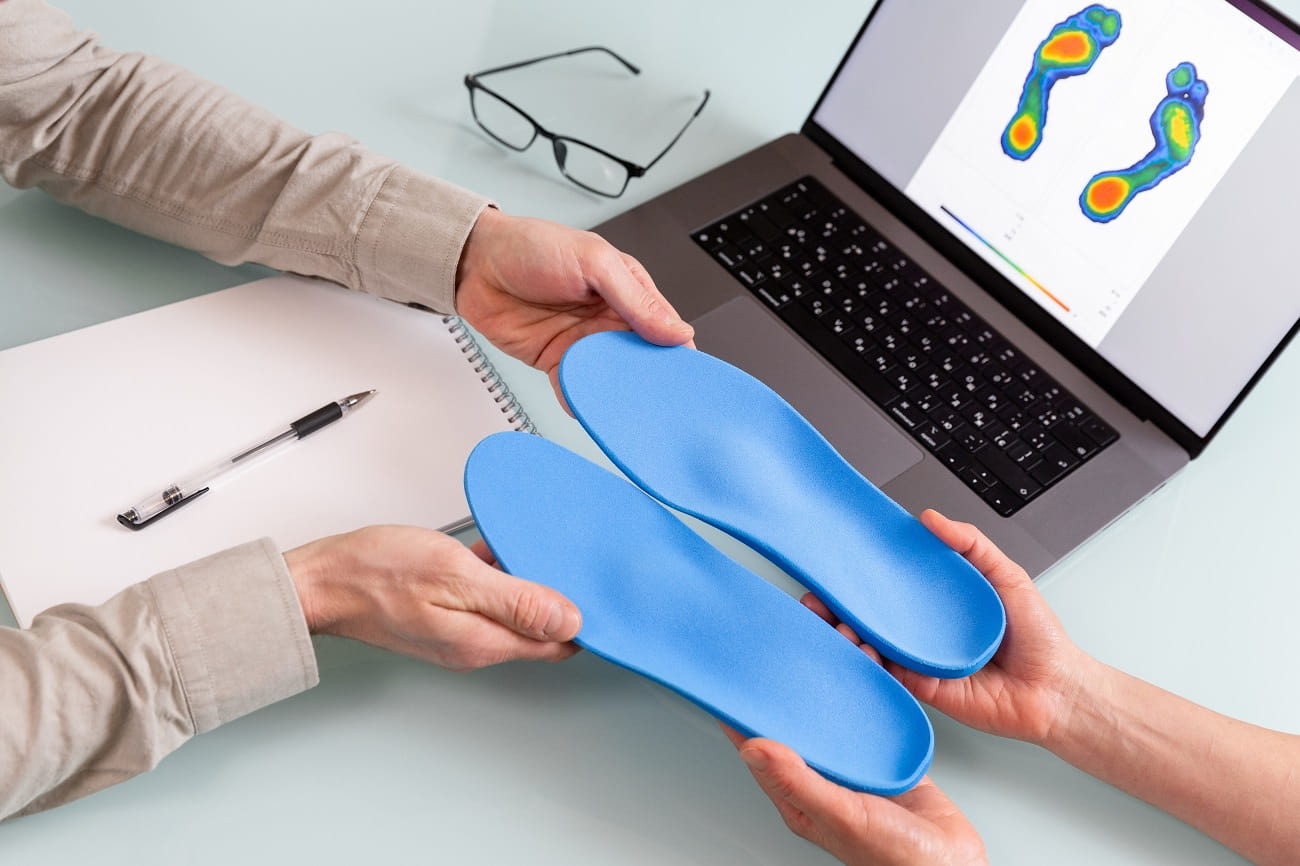Initial FAQuestions – Customer Support
1. What is an “Insole”?
insoles are removable supports, typically made from materials such as thermoplastic, EVA (Ethylene Vinyl Acetate), cork, or carbon fiber, designed to restore and enhance your natural foot function. These insoles work by realigning the foot and ankle bones to their neutral position, which helps in restoring proper biomechanics.
2. What materials are used to make insoles?
Insoles are generally crafted from durable materials such as firm plastic (EVA), carbon fiber, or cork, often covered with fabrics like Alcantara, leather, or felt. The choice of material and density affects the cushioning and support the insole offers.
3. Who can benefit from using Orthotic Insoles?
Individuals with structural foot issues, like flat feet or high arches, or those experiencing heel pain, lower back discomfort, or general foot issues may find relief through orthotic insoles, which help correct walking imbalances.
4. What makes Biofoot custom orthotics stand out?
We prioritize exceptional care and follow-up support. After providing your new orthotics, we conduct follow-up checkups to ensure they improve your comfort. If adjustments are needed, we make them and check in with you to ensure they feel right.
5. Are orthotics compatible with soft and flexible shoes?
It’s not recommended as they often lack the stability needed to support the orthotic effectively.
6. Will my insurance cover the cost of my insoles?
We do not offer direct billing through insurance. However, you should check with your insurance provider to determine if insoles or orthotics are covered under your policy, typically listed as medical appliances or durable medical equipment. If covered, you can claim the cost through reimbursement.
FAQuestions – Technical Specialist
1. How long do orthotic insoles last?
Custom orthotics typically last 2-3 years, while over-the-counter options last around 6-12 months, depending on how frequently they are used.
The lifespan of foot orthotics varies by individual, depending on materials, foot structure, activity levels, and physical condition. Rather than focusing solely on when the cover material wears out, consider how long the insoles continue to meet your needs for support, correction, and pressure redistribution. If symptoms return, it’s advisable to have your orthotics reassessed for potential modifications or replacements.
2. Can I use orthotics in every type of shoe?
No, orthotics should be worn in supportive shoes. Styles like low-profile dress shoes may not provide the necessary space or support for orthotics.
3. Can I wear orthotics in sandals?
Yes, but select sandals with removable insoles for proper fit and support.
4. When should I replace my insoles?
Insoles should be replaced periodically to ensure ongoing comfort, support, and effectiveness. The replacement timeline varies depending on factors such as usage, foot growth, and wear and tear. Regular replacements will help maintain optimal foot health, comfort, and performance.
Over-the-counter insoles should be replaced annually, while custom orthotics can last up to two years or longer depending on usage with regular checkups and maintenance.
For Adults:
– Typically, insoles should be replaced every 6-12 months if you notice significant wear, tear, or loss of support.
– If you experience changes in foot pain, discomfort, or alignment, it may be time to reassess and replace your insoles.
For Children:
– Due to rapid foot growth, children’s insoles typically need to be replaced more frequently.
– If your child’s foot size increases by more than two sizes, it’s likely time to replace their insoles to ensure a proper fit and continued support.
5. Will orthotics change the shape of my feet?
No, orthotics do not alter foot shape; they provide support while worn, like prescription glasses for vision.
6. Do Custom insoles Cure Flatfeet?
No. Flat feet is a condition that cannot be cured without surgery to change the foot’s structure. However, insoles, especially if customized, can improve flat feet. Insoles do not cure flat feet, but they can help reduce associated symptoms like pain, thereby improving foot biomechanics.
7. Can I stop using orthotics?
It depends on individual circumstances. Some may need them only temporarily for recovery, while others may benefit from ongoing use.
8. Can you modify the insoles I received from another facility?
Yes, we can assess and potentially modify insoles from other facilities. Once you confirm, you can bring them in for a consultation to evaluate what adjustments may be possible.
9. How long does it take to make custom orthotics?
Customized insoles typically take 2-4 days to manufacture in-house. However, custom-made CAD insoles created in Germany may take 3-4 weeks, depending on shipping speed and the complexity of the orthotic prescription.
10. Do you offer Running Analysis?
We do not conduct traditional Running Analysis. Instead, we utilize a pressure mapping device called Foot Work Pro, which provides dynamic and multi-dynamic analysis with unlimited STEPS measurements for an accurate understanding of foot function. Additionally, we perform a 3D scan to create a precise digital cast of your foot, ensuring tailored solutions.
11. What measurements/methods do you use to customize my shoes/orthotics?
We utilize a combination of advanced technologies to capture precise measurements and impressions of your feet, including:
– 3D scanning for accurate foot shape and volume capture
– Foot pressure mapping to analyze distribution of pressure and weight-bearing areas
– Foam box foot impressions for a precise mold of your foot shape
– Podoscan and Laser for foot and leg alignment.
– 2D scanning for additional foot shape and size analysis
These advanced methods ensure a precise fit and optimal support for your custom-made shoes or orthotics.
12. How can I ensure the best fit for my orthotics?
Bring your shoes to the fitting appointment so our specialists can assist in tailoring the orthotics for optimal comfort and functionality.
General Questions Asked:
13. How long does it take to adjust to wearing insoles for the first time?
Gradual wear is recommended; it typically takes about 2-3 weeks for your feet to fully adjust. Initial discomfort may occur, particularly in severe cases, but it is usually temporary.
14. Can I exercise or run while using orthotic insoles?
Yes, but it’s advisable to get used to the insoles before diving into intense workouts. Start gradually to allow your body to adapt.
15. Do I need larger shoes for my orthotics?
No, you should always buy shoes that fit properly. Most shoes come with removable inserts, allowing you to accommodate your orthotics without needing to size up.
16. Can I wear orthotics with high heels?
Yes, but only if they are specially designed for such footwear. Regular high heels may not accommodate orthotic inserts comfortably.
17. Are softer gel insoles better?
Not necessarily. While cushioning is important, support is also crucial. A semi-rigid insole often provides the best balance of both.
18. What are the differences between soft, rigid, and semi-rigid insoles?
– Soft Insoles: Offer cushioning and pressure relief, ideal for conditions like arthritis, diabetic foot with high pressure areas.
– Rigid Insoles: Provide structural support to correct alignment and control foot movement.
– Semi-Rigid Insoles: Combine cushioning of soft insoles with the support of rigid ones, suitable for many activities and conditions.
19. Can I use orthotics for specific sports or activities?
Yes, orthotics can be customized based on the specific demands of different sports or activities, enhancing performance and comfort.
20. What should I look for in supportive footwear?
Look for shoes with a firm heel counter, adequate arch support, a flexible forefoot, and a deep toe box for optimal fit with orthotics.
21. How can I clean my orthotics?
Clean your orthotics with a damp cloth and mild soap. Air dry them away from direct heat to maintain material integrity.
22. Are there any risks associated with using orthotic insoles?
While generally safe, improper use or fitting can lead to discomfort or reduced effectiveness. It’s crucial to ensure proper fit and function through assessments.
23. What type of shoes can I wear with orthotics?
The type of shoes you can wear with orthotics depends on the specific insoles you have. We offer a wide selection of comfort and orthopedic shoes that are designed to accommodate both custom-made and prefabricated orthotic insoles, all of which come with removable insoles.
24. What is the difference between readymade and custom insoles?
Readymade or off-the-shelf orthotics are generally more affordable but are designed as a one-size-fits-all solution with a standard arch. While they may provide some benefit, they often lack the precise shape and support needed for individual requirements. On the other hand, custom-made orthotics are tailored to your unique needs, determined through a comprehensive examination or scanning process, ensuring optimal fit and function.
25. Do you make Orthopedic Custom-Made Shoes?
Yes, we offer custom-made shoes designed to suit individual needs and preferences. Our custom-mad shoes are designed to provide optimal comfort, support and correction for various foot conditions. A thorough evaluation and precise measurements are made to ensure perfect fit and optimal support tailored to your needs.



